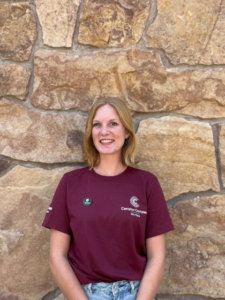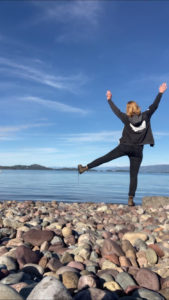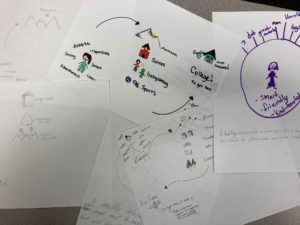
The inside of my wrist is tattooed with a pencil. Cliché, perhaps, for an English major, but more important to me now than it was when I got it in 2019. It was the start of my Junior year, and I was reeling from an Emily Dickinson poetry class that had shattered my world and proved to me that I had something to say. My tiny pencil tattoo commemorates the discovery of my own voice.
Today, the Montana leaves are colored like millions of tiny wildfires and I am 956 miles from my family. I’m homesick. I’m goosebumped with end-of-autumn breezes. I mentor math, of all things! I’m uprooted and uncertain and untethered but when the sun comes through my windshield and shows me the bejeweled Mission Mountains, my heart drops. I have dreamt of golden prairies and endless forests and I am here now, witnessing it all. I roll my windows down and push my sleeves up, the pencil tattoo riding air down the highway.
I’m only two months into service, but my car has broken down three times already. Of course now, during the most unsteady transition in my young life, is the perfect time for my Crosstrek to require almost my entire savings in repairs. This is the universe’s way of teaching me to release control and trust my path, I’m sure. But embarrassingly, I’ll admit that it has caused me to stress-cry in front of my Subaru mechanic (sorry Kyle). So today, as I drive to my service site, I am thankful for sunshine and big mountains and a car that doesn’t sound like it might explode when the key turns. Little victories.

When I arrive, I walk into a high school classroom and begin by checking in with my math students. I’m learning to know how they are doing just by their eyes, regardless of whether they tell me they’re “just fine” or not. It’s become my priority to show them that their well-being precedes any academic agenda. For these students, asking for help is a complex issue; generational trauma teaches many– especially those in rural, impoverished America– that vulnerability is shameful and dangerous. Slowly, these students are allowing me to build trust with them. It feels a lot like my car troubles do– requiring everything I’ve saved, unpredictable, a gradual accumulation of safety and care. It is not always beautiful. It is always necessary. Some days, very little math gets learned. But I have to believe that having conversations about their hearts and minds matters more than equations, anyway.
After math, I move myself down the hallways to the middle school art room, where I meet with Upward Bound students. These students are enrolled in a program that helps them through high school and into college. It is my responsibility to provide academic and personal support to help them achieve their goals. On this particular day, I’ve brought paper and markers for a lesson I’ve cleverly titled “Planning for Life.” Discussions questions ready, I welcome my students into the room and explain that today, we are going to creatively represent our dreams for college and beyond.
“Why do you think it’s important to think about your dreams in life?” I pass out supplies. They avoid my eyes, suddenly silent. I wait a few more seconds before uncapping my Expo. “Because high school is just one step. Next comes college and then after that, the rest of your life. You are allowed to dream as big as you want!” I pass around my own crude drawing as an example. Across the whiteboard, I write a few question prompts: What life do you dream of having? What are your goals? How will you accomplish those goals?

Slowly, they take to their own papers. I watch their markers create stick figures, tiny families, airplanes, apartment buildings, colleges, and stethoscopes. They create multicolored worlds, and soon, the room fills with chatter. It isn’t that they did not know how to dream. All students know how to envision big and beautiful worlds beyond our own– that’s why I love high schoolers so much. These students just stumbled with the vocabulary of their futures, sticky in their mouths like bubblegum. Poverty is trapping enough to rob youth of the words needed to bring imaginations into reality. I did not know that allowing yourself to dream is a privilege, but it is; dreams represent the hope of cycles broken, families pulled out of poverty, resources no longer scarce. Hope is a dangerous thing. It must be protected and nurtured.
The bell rings. I pack up my supplies and say goodbye to my students, but one of them is slow to clean up. She lingers with me as I’m zipping my backpack. “Remember when you taught us about safe sex and condoms?” I laugh. Of course I do. A few weeks ago, my students asked me if I knew about STDs, so I brought them pamphlets from the Health Center. I had some discussion questions planned, but was completely unprepared when they asked me how condoms work. I had nothing except my own hand, so I rolled a condom over my fingers for demonstration. I was trying so hard to appear as a confident, non-judgemental mentor for them. And then I freaked out in my car, hands sticky and heart pounding with the responsibility of educating teens about sex. Gross and weird and wild and real. Life is never what you expect.
The student sticks her tongue out when she remembers the condom. She giggles. We walk down the hallway together. “It’s like, crazy that you help us with all of that. I liked drawing today,” she says. I tell her how amazing her dreams are and how excited I am to watch her and her peers grow.
“You are an incredible human who is going to live an incredible life.”
“I am?”
“Yes.”
“Thank you.”
And she’s gone, running to catch her friends for lunch. I get in my car and when it starts, I say a little prayer of gratitude in my head. I run my thumb over my pencil tattoo. My own voice. The dreams of teenagers. “Yes.”
They are worth it. This is worth it. For all the times my car has broken down. For my ruined savings account. For an English major in a math class. For a condom unrolled in the middle of an art room. For a whole world that needs everyone in it. A thousand times, yes.
 Blog
Blog